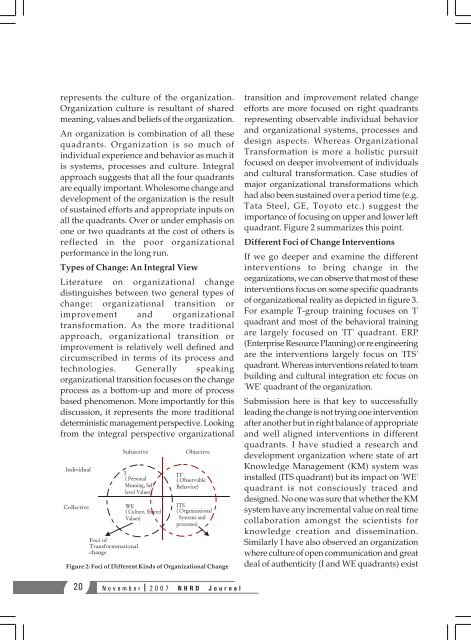NHRD Journal - National HRD Network
NHRD Journal - National HRD Network
NHRD Journal - National HRD Network
Create successful ePaper yourself
Turn your PDF publications into a flip-book with our unique Google optimized e-Paper software.
epresents the culture of the organization.<br />
Organization culture is resultant of shared<br />
meaning, values and beliefs of the organization.<br />
An organization is combination of all these<br />
quadrants. Organization is so much of<br />
individual experience and behavior as much it<br />
is systems, processes and culture. Integral<br />
approach suggests that all the four quadrants<br />
are equally important. Wholesome change and<br />
development of the organization is the result<br />
of sustained efforts and appropriate inputs on<br />
all the quadrants. Over or under emphasis on<br />
one or two quadrants at the cost of others is<br />
reflected in the poor organizational<br />
performance in the long run.<br />
Types of Change: An Integral View<br />
Literature on organizational change<br />
distinguishes between two general types of<br />
change: organizational transition or<br />
improvement and organizational<br />
transformation. As the more traditional<br />
approach, organizational transition or<br />
improvement is relatively well defined and<br />
circumscribed in terms of its process and<br />
technologies. Generally speaking<br />
organizational transition focuses on the change<br />
process as a bottom-up and more of process<br />
based phenomenon. More importantly for this<br />
discussion, it represents the more traditional<br />
deterministic management perspective. Looking<br />
from the integral perspective organizational<br />
Figure 2: Foci of Different Kinds of Organizational Change<br />
transition and improvement related change<br />
efforts are more focused on right quadrants<br />
representing observable individual behavior<br />
and organizational systems, processes and<br />
design aspects. Whereas Organizational<br />
Transformation is more a holistic pursuit<br />
focused on deeper involvement of individuals<br />
and cultural transformation. Case studies of<br />
major organizational transformations which<br />
had also been sustained over a period time (e.g.<br />
Tata Steel, GE, Toyoto etc.) suggest the<br />
importance of focusing on upper and lower left<br />
quadrant. Figure 2 summarizes this point.<br />
Different Foci of Change Interventions<br />
If we go deeper and examine the different<br />
interventions to bring change in the<br />
organizations, we can observe that most of these<br />
interventions focus on some specific quadrants<br />
of organizational reality as depicted in figure 3.<br />
For example T-group training focuses on 'I'<br />
quadrant and most of the behavioral training<br />
are largely focused on 'IT' quadrant. ERP<br />
(Enterprise Resource Planning) or re engineering<br />
are the interventions largely focus on 'ITS'<br />
quadrant. Whereas interventions related to team<br />
building and cultural integration etc focus on<br />
'WE' quadrant of the organization.<br />
Submission here is that key to successfully<br />
leading the change is not trying one intervention<br />
after another but in right balance of appropriate<br />
and well aligned interventions in different<br />
quadrants. I have studied a research and<br />
development organization where state of art<br />
Knowledge Management (KM) system was<br />
installed (ITS quadrant) but its impact on 'WE'<br />
quadrant is not consciously traced and<br />
designed. No one was sure that whether the KM<br />
system have any incremental value on real time<br />
collaboration amongst the scientists for<br />
knowledge creation and dissemination.<br />
Similarly I have also observed an organization<br />
where culture of open communication and great<br />
deal of authenticity (I and WE quadrants) exist<br />
20<br />
November 2007 <strong>N<strong>HRD</strong></strong> <strong>Journal</strong>
















